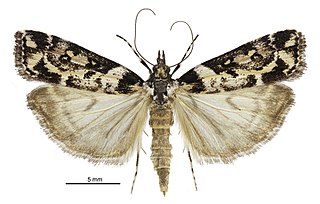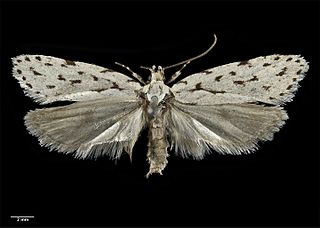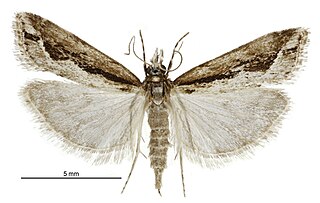
Asterivora nivescens is a species of moth in the family Choreutidae. It is endemic to New Zealand and has been observed in Nelson. This species inhabits native herbage on mountain sides. Adults of this species are on the wing in January.

Eudonia diphtheralis is a species of moth in the family Crambidae. It is endemic to New Zealand.

Izatha heroica is a moth of the family Oecophoridae. It is endemic to New Zealand, where it is widespread in the west part of the South Island. It has been collected in southern beech forests but larvae have been reared on dead kanuka or manuka bushes.

Eudonia steropaea is a species of moth of the family Crambidae. It was named by Edward Meyrick in 1884. Meyrick gave a detailed description of this species in 1885. It is endemic to New Zealand.

Trachypepla euryleucota is a species of moth in the family Oecophoridae. It is endemic to New Zealand and can be found throughout the country, inhabiting native forest. The larvae are leaf litter feeders and have also been found feeding on and in bird nests. Adults are on the wing from December to March, are nocturnal and are attracted to light. During the daylight hours they can be sometimes be observed resting on walls or fences. It has been hypothesised that the adults resemble an opening manuka flower bud or bird droppings in order to camouflage themselves from predators. The raised tufts on their forewings possibly also assist with camouflaging this moth when they rest on lichen.

Scoparia nomeutis is a moth in the family Crambidae. It was named by Edward Meyrick in 1884. Meyrick gave a description of this species in 1885. It is endemic to New Zealand.

Scoparia indistinctalis is a species of moth in the family Crambidae. It is endemic to New Zealand.

Scoparia petrina is a species of moth in the family Crambidae. It was named by Edward Meyrick in 1884. Meyrick gave a description of the species in 1885. It is endemic to New Zealand.

Scoparia trapezophora is a species of moth in the family Crambidae. It is endemic in New Zealand.

Orocrambus ornatus is a moth in the family Crambidae. This species is endemic to New Zealand. It is classified as critically endangered by the Department of Conservation.
Eudonia epicryma is a moth in the family Crambidae. It was described by Edward Meyrick in 1885. It is found in Australia, where it has been recorded from South Australia.
Eudonia eremitis is a moth in the family Crambidae. It was described by Edward Meyrick in 1885. It is found in Australia, where it has been recorded from South Australia.

Eudonia microphthalma is a moth in the family Crambidae. It was described by Edward Meyrick in 1884. It is endemic to New Zealand.
Eudonia perierga is a moth in the family Crambidae. It was described by Edward Meyrick in 1885. It is found in Australia, where it has been recorded from Tasmania.

Eudonia philetaera is a moth in the family Crambidae. It was named by Edward Meyrick in 1884. Meyrick gave a description of the adult moth in 1885. It is endemic to New Zealand.
Eudonia exilis is a moth in the family Crambidae. It was described by Henry Guard Knaggs in 1867. It is found in New Zealand.
Scoparia gomphota is a moth in the family Crambidae. It was described by Edward Meyrick in 1885. It is found in Australia, where it has been recorded from Tasmania.
Scoparia tritocirrha is a moth in the family Crambidae. It was described by Alfred Jefferis Turner in 1918. It is found in Australia, where it has been recorded from Norfolk Island.

Opsitycha squalidella is a moth of the family Oecophoridae. It was described by Edward Meyrick in 1884. This species is native to Australia and is likely adventive to New Zealand.

Trachypepla galaxias is a moth of the family Oecophoridae first described by Edward Meyrick in 1883. It is endemic to New Zealand and can be found throughout the country. This species inhabits native forest. The life history of this species is currently unknown. Adults are on the wing from October to February, are nocturnal and are attracted to light.













